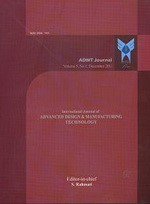-
-
List of Articles
-
Open Access Article
1 - Workspace Analysis of 2-PR(Pa)U- 2-PR(Pa)R New Parallel Mechanism
Mehran Mahboubkhah Sajjad Pakzad -
Open Access Article
2 - Fuzzy-GSA Based Control Approach for Developing Adaptive Cruise Control
M. Bostanian -
Open Access Article
3 - Experimental Study of the Effect of Impeller Geometrical Parameters on Fluid Hydrodynamics in Copper Solvent Extraction Mixer
S. Parvizi S. Aosati E. Keshavarz Alamdari -
Open Access Article
4 - Impact of Energy Dampers in Improvement of Impulsive Response of Double Layer Grids Space Structures
H. Zarrintala A. Maleki M. Darvishhashemi -
Open Access Article
5 - Mechanical Design and Simulation of a Saddle-Assistive Device for Sit-to-Stand Transfer in Healthy Subjects
A. Hojjati Najafabadi S. Amini F. Farahmand -
Open Access Article
6 - Genetic Algorithm and ANN for Estimation of SPIV of Micro Beams
M. Heidari -
Open Access Article
7 - Synthesis of B4C - Nano TiB2 Composite Nano Powder by the Chemical Precipitation Method
M. Saeedi Heydari H. R. Baharvandi -
Open Access Article
8 - Modeling and Design of a Disk-Type Furrow Opener’s Coulter Its Mechanical Analysis and Study for No-Till Machinery (Combination and Bertini)
J. Ghezavati M. Abbasgholipour B. Mohammadi Alasti A. Shirneshan A. Shadkam -
Open Access Article
9 - Estimation of Surface Roughness in Turning by Considering the Cutting Tool Vibration, Cutting Force and Tool Wear
A. Salimi A. Ebrahimpour M. Shalvandi E. Seidi -
Open Access Article
10 - Stress and Displacement Analysis of First Molar Hollow Tooth during Dental Filling Operation using Three-Dimensional Finite Element Method
M. R. Karamooz-Ravari B. Shahriari E. Seyfali -
Open Access Article
11 - Fabrication of AA1060/Al2O3 Composites by Warm Accumulative Roll Bonding Process and Investigation of its Mechanical Properties and Microstructural Evolution
M. Heydari Vini P. Farhadipour
-
The rights to this website are owned by the Raimag Press Management System.
Copyright © 2021-2025







